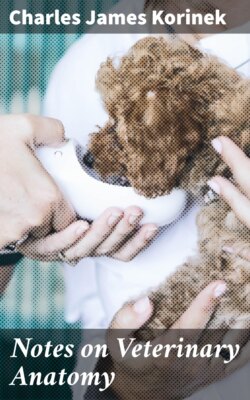Читать книгу Notes on Veterinary Anatomy - Charles James Korinek - Страница 6
На сайте Литреса книга снята с продажи.
RUMINANTIA.
ОглавлениеTable of Contents
(Cud Chewing Animal.)
In this class we take the ox as the animal which represents the best for our purpose, the family of ruminating or cud-chewing animals, as cattle, sheep and goats.
The Skull or Cranium.—In the skull of the ox an important feature is the development of the frontal or forehead bone, which extends from below the eyes to the back of the skull, forming the entire forehead and crest or top, in the middle of which is the forehead tuberosity or knob-like elevation, which is very large in hornless animals. Springing from the sides of the top are two processes, varying in size and shape, but corresponding to the shape of the horns, which they support.
Vertebrae.—The true vertebral column is made up of 26 bones divided into seven cervical or neck-bones, 13 dorsal or back-bones, and six lumbar or loin bones.
Cervical or Neck-Bones.—The bodies of these bones are shorter than those of the horse, but same in number.
Dorsal or Back-Bones.—These bones are longer than in the horse, but have the same general form. It gives attachment to 13 ribs on each side in the same manner as those of the horse.
Lumbar or Loin Bones.—The lumbar vertebrae are longer and thicker than in the horse, their bodies being more round on the sides and lower surfaces.
Sacrum, or Rump Bones.—The sacrum is larger and more arched, and the upper surface more round than in the horse.
Coccygeal or Tail Bones.—The tail bones are from 15 to 20 in number, are strong and rougher than those of the horse.
Pelvis or Hip Bones.—The pelvis is larger, but presents the same general appearance as in the horse.
In studying the bones of the limbs in ruminants, the only point of difference is in bones below the knee. The large metacarpal bone presents a vertical groove down its front, which marks the original division of the bone into two bones. The lower extremity is divided by a deep groove into two articulations, each resembling the single one of the horse. The outer one being always the smaller, a rudimentary metacarpus is placed on the back and outer surface. The pasterns and sesamoids in either limb are double, one set forming each digit; they are small and narrow, the coffin bone resembles half of that of the horse, equally divided.
In the aged ruminant, two bones are commonly found in the heart, and may be termed the cardiac bones. They are found related with auriculo-ventricular rings. In shape they present three angles, three borders, and two surfaces. The left bone is somewhat smaller than the right.
